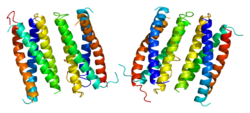Ciliary neurotrophic factor is a protein that in humans is encoded by the CNTF gene. [5] [6] [7]
Contents
- Therapeutic applications
- Satiety effects
- Recombinant human CNTF (Axokine)
- NT-501
- Interactions
- See also
- References
- Further reading
- External links
The protein encoded by this gene is a polypeptide hormone and neurotrophic factor whose actions have mainly been studied in the nervous system where it promotes neurotransmitter synthesis and neurite outgrowth in certain neural populations including astrocytes. It is a hypothalamic neuropeptide that is a potent survival factor for neurons and oligodendrocytes and may be relevant in reducing tissue destruction during inflammatory attacks. A mutation in this gene, which results in aberrant splicing, leads to ciliary neurotrophic factor deficiency, but this phenotype is not causally related to neurologic disease. In addition to the predominant monocistronic transcript originating from this locus, the gene is also cotranscribed with the upstream ZFP91 gene. Cotranscription from the two loci results in a transcript that contains a complete coding region for the zinc finger protein but lacks a complete coding region for ciliary neurotrophic factor. [7]
CNTF has also been shown to be expressed by cells on the bone surface, and to reduce the activity of bone-forming cells (osteoblasts). [8]






